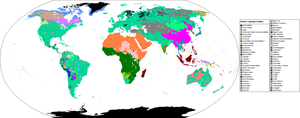User:Chrysophylax/Creating an Indo-European Conlang
| ||||||||||||||
Foreword
The moniker “Indo-European languages” represent one of the most studied (if not the most) language families of the world; quite a few of history's great cultural hegemons have been part of this family, a fact which is most storngly noticed when one surveys the amount of research.
The family is also one of the largest language family in the world in terms of native speakers. Languages as different as English (365 million), Latin (few to none), Ancient Greek (few to none), Hindi-Urdu(361 million), Russian (162 million), Welsh (720,000), and Armenian (6 million) all belong to this gigantic, sprawling family.
All in all, Indo-European languages offer the conlanger ample material from which to draw upon when engaging in lighthearted linguogenesis, what with detailed grammars, lexica, recordings, dissertations, and so on. Whether it be Aarlaansk (a descendant of Latin in northwestern Europe), Harākti (a sibling of Hittite), Gutiskar (Germanic), Syrunian (a Levantine descendant of Latin), Thorian (a close relative of the Greek family), Quadian (an 'old Germanic' language) or belonging to a whole new branch entirely as Alkalic, Nṛtranya (a language drawn from a 'reconstructed PIE'-lexicon based on mostly Proto-Germanic words then taken down through Sanskrit-y sound changes) or Dhannuá (a melangemischung of Celtic, Italic, and Germanic elements), Indo-European-derived languages don't seem to be ceasing in popularity or creativity any time soon.
As the Indo-European family has an abundance of material written on it, while making the task easier for the conlanger when it comes to deriving new words, it also enforces a modicum of accountability; the Indo-European topic-focus conlang, while completely plausible, sure does have some explaining to do. Basically, it's a lot harder to just make things up out of thin air. On the other hand, you are presented with a wealth of already existing linguistic resources with which to play; a prefabricated sandbox of joy; a themed linguistic LEGO® set with hundreds of manuals and configurations available that resonate across continents.
It is useful to read some literature on the Indo-European family and its reconstructed last common ancestor Proto-Indo-European (commonly referred to as PIE). By reading about the proto-language one comes to a greater understanding of many irregularities in the modern descendants. E.g., English's “difficult” strong verbs: sing, sang, sung; spring, sprang, sprung; give, gave, given, or Latin's rare reduplicating verbs, e.g., disco, didici ; tango, tetigi. Not only are these processes all understandable when viewed from an Indo-European point of view; they also provide lots of ideas for the conlanger!
While ultimately not 'super' necessary for the conlanger who's creating a descendant of Modern English as spoken by a mix of Ameri-Russo-Japanese space explorers 200 years from now on the moon of Titan, it is quite useful to familiarise oneself with many of the concepts discussed in Indo-European linguistics when guiding conlangs through a linguistic conhistory.
- Recommended introductory reading
- Proto-Indo-European language at Wikipedia
- Donald Ringe's From Proto-Indo-European to Proto-Germanic (2006), ISBN 9780199284139
- Mallory, JP; Adams, DQ The Oxford Introduction to Proto-Indo-European and the Proto-Indo-European World (2006), ISBN 9780199296682
- Various books on Proto-Indo-European with "introduction" in their titles.
As you familiarise yourself more and more with the Indo-European languages, you start stumbling onto a few questions regarding your conlang — do I want my own branch? my own descendant of an already existing branch? a contact language between two branches? a descendant of a specific language? — these are all valid questions and options available to you when crafting it.
When creating a descendant, looking at how the language you're basing your conlang on developed compared to its siblings can be a helpful exercise in determining general trends and may even spark some ideas for your own language!
On the other hand, if you choose to innovate a whole new language based on PIE itself you have a the delightful task of deciding in which direction to take it. Again, reviewing languages you personally enjoy and their history can be quite a powerful tool when it comes to ideogenesis.
If you feel like joining la grande famille in terms of both nat- and conlangs, you've stumbled onto the right place,
— User:Chrysophylax, editor.
nota bene: this page is a living document and is prone to sudden changes at any time. If you wish to find a previous version, please use the history tab. When linking to people outside of the wiki, it is recommended that you link directly to the version you are seeing as the state of the document cannot be guaranteed for the future.
A whole new world: creating your own PIE-derived language
If you find that making romlangs, germlangs, slavlangs, sinolangs, celtlangs just a bit too constraining, the option of making up your own base on which to experiment further on is a safe bet for fun! The reasons for engaging in diachronic conlanging with PIE as point of origin are many and varied - just like the results. By building your own branch of the Indo-European tree you'll have lots of exciting moments dealing with concepts like common innovations, isoglosses, borrowings, conservatism-innovation, and so on.
This chapter assumes a basic understanding of concepts such as phoneme, allophone, ablaut, word order, and so on.
The processes of change and their effects
The primary driving force of linguistic change is […] […]these interact in many ways making […] In the next three parts we will discuss them separately […]
Forging a phonology
Proto-Indo-European is commonly accepted to have had the following vowel and consonant inventory
You have many options available in the treatment of the vowels and consonants; already in Proto-Indo-European we discern a trend towards either engaging in af/fricativisation or not of the 'palatovelars'. This important isogloss divides Indo-European into two broad swaths: Centum and Satem. Cf. with the reconstructed PIE *(d)ḱm̥tóm.
